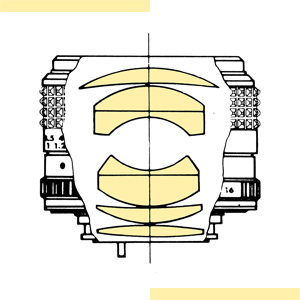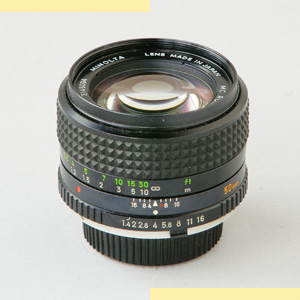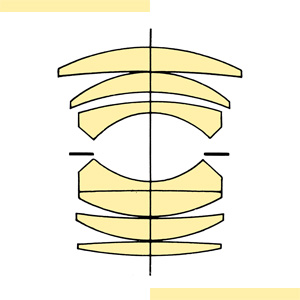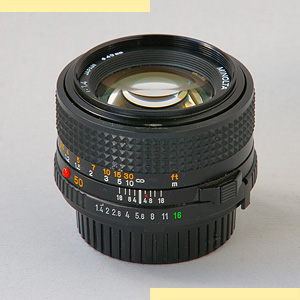Deutlich später als die meisten wichtigen Konkurrenten, die bereits in den 1960er Jahren ein 1.4/50mm euf den Markt gebracht hatten (Canon, Nikon, Pentax), kam Minolta mit einem 1.4/50mm auf den Markt. Zuvor war das MC 1.4/58mm (das in Wirklichkeit ein Brennweite von ungefähr 60mm aufwies) das lichtstarkte Minolta-Normalobjektiv gewesen. Zumindest die überarbeitete zweite Variante des MC 1.4/58mm kann durchaus mit dem ersten 1.4/50er aus dem Hause Minolta konkurrieren.
Minolta-Objektive mit den Eckdaten 1.4/50 mm fürs SR-Bajonett wurden in mindestens vier optisch unterschiedlichen Varianten gebaut:
1) Das MC-X 1.4/50 mm (1973), ein Siebenlinser in fünf Gliedern, der in seiner Konstruktion an das legendäre MC 1.2/58 mm von 1968 angelehnt ist
2) Das MD-I/-II 1.4/50 mm (1977), ebenfalls ein Siebenlinser in fünf Gliedern
3) Das MD-II 1.4/50 mm (1979), ein Siebenlinser in sechs Gruppen
4) Das MD-III 1.4/50mm (1981), dessen optische Rechnung vermutlich auch im Minolta AF 1.4/50 mm zu finden ist
Alle genannten Objektive zeichnen leicht abgeblendet an APS-C (16 MP) praktisch gleich scharf; die neueren MD-Konstruktionen sind bei Offenblende aber eine Spur detailreicher als das MC 1.4/50 mm.
Das MC 1.4/50 mm ist abgeblendet selbst am 36MP Vollformat gut zu gebrauchen; offen bei f1.4 stört allenfalls ein niedriger Mikrokontrast (LoCAs mit rosa Überstrahlung der feinen Bilddetails) und eine gewisse Bildfeldwölbung (die aber bei available light Aufnahmen in der Regel nicht negativ auffällt).
Performance of the MC-X [7/5] version on 16 MP APS-C (reproduced with permission fom Benjamin Gövert / vintagelensreviews.com):
The MC Rokkor-PG 50 mm f/1.4 is the successor of the MC Rokkor-PF 58 mm f/1.4. The 50 mm is often said to be Minoltas sharpest standard prime in the SR system, although some insist that the MC Rokkor-PG 58 mm f/1.2 wins this battle by a hair (heads up: it doesn’t!).
The lens feels fantastic, focus is buttery smooth and the weight balances well on a NEX-5T. Optical qualities wide open and the effective focal length of 76 mm on APS-C cameras make the MC Rokkor-PG an excellent portrait lens.
The lens is hazy and slightly soft at f/1.4, with consistent performance across the frame. The haze mostly clears at f/2 and contrast improves considerably pushing the perceived sharpness. Resolution increases visibly starting at f/2.8, when the last bit of haze disappears from the corners. From f/2.8 on, the lens clearly outperforms the Sony SELP1650 kit zoom resolution wise. Sharpness reaches excellent levels from f/4 to f/8 with consistent performance across the frame. Diffraction ever so slightly softens f/11 and gives the image a pronounced softness at f/16.
Chromatic aberrations are blurred away at f/1.4 due to strong hazing. A red and cyan glow becomes visible at f/2 and transforms to clear, very small CAs at f/2.8. The CAs decrease slightly when stopping down, but never disappear completely. A good to very good performance for an achromatic lens.
Vignetting is about 2/3 of a stop at f/1.4, improves nicely at f/2 and is gone by f/2.8. The MC Rokkor-PG also exhibits a slight barrel distortion of -0.5%. The effective T-stop at f/1.4 is approximately T1.6 (-0.4 EV), which is okay.
Compared to the MC Rokkor-PF 58 mm f/1.4, the 50 mm f/1.4 is certainly the better lens. While is shows a bit more chromatic aberration, it is sharper up to f/4, has superior contrast and the better corner performance. In a contest with the MD-I Rokkor 50 mm f/1.4, though, there is no clear winner. The MD shows slightly more haze in the corners up to f/2 but higher contrast in the center. The MC features a slightly higher sharpness at these apertures. From f/2.8 on, both lenses are very, very close in terms of resolution & sharpness and probably indistinguishable at f/4 to f/16. But the MD has the advantage of showing less chromatic aberration. In the battle of the f/1.4 normal primes, the MC Rokkor-PG 50 mm is your specialist for wide-open apertures, the MC Rokkor-PF 58 mm is the one for dreamy retro shots and the MD Rokkor 50 mm probably is the best allround performer
Performance of the MD-I [7/5] version on 16 MP APS-C (reproduced with permission fom Benjamin Gövert / vintagelensreviews.com):
The MD Rokkor 50 mm f/1.4 with 55 mm filter thread is the direct successor of the MC Rokkor-PG 50 mm f/1.4. It uses a new optical formula, is smaller and has very different image characteristics.
The lens is slightly hazy and soft at f/1.4 with acceptable contrast. The haze still affects the corners at f/2, but contrast in the center is improved. Sharpness and corner performance increase radically at f/2.8 with the haze disappearing. The center reaches good sharpness, now. The latter increases to very good at f/4 and excellent from f/5.6 to f/8 with consistent performance across the whole image. Diffraction starts at f/11 and softens up the image at f/16.
A slight red and very dark cyan glow is visible at f/1.4 and f/2 in haze-affected areas. f/2.8 shows some very small color fringes. Starting at f/4, the lens is practically free of CAs, which are hardly visible even at 200% magnification. An outstanding performance for an achromatic lens.
Vignetting is about 2/3 of a stop at f/1.4, improves nicely at f/2 and is gone by f/2.8. The lens also exhibits a slight barrel distortion of -0.7%. The effective T-stop at f/1.4 is approximately T1.6 (-0.4 EV), which is okay.
In a contest with the MC Rokkor-PG 50 mm f/1.4 there is no clear winner. The MD shows slightly more haze in the corners up to f/2 but higher contrast in the center. The MC features a slightly higher sharpness at these apertures. From f/2.8 on, both lenses are very, very close in terms of resolution & sharpness and probably indistinguishable at f/4 to f/16. But the MD has the advantage of showing less CAs. In conclusion, the MD Rokkor 50 mm f/1.4 is an excellent allround performer, whilst the MC Rokkor-PG is your specialist for wide-open apertures. If you’re looking for more dreamy, “retro”-like shots, have a look at the MC Rokkor-PF 58 mm f/1.4.
Performance of the MD-II [7/6] version on 16 MP APS-C (reproduced with permission fom Benjamin Gövert / vintagelensreviews.com):
The lens shows acceptable sharpness wide with some haze, minor purple fringing and pretty decent contrast. The performance is consistent across the whole frame. Sharpness slightly increases when stopping down to f/2 and the prominence of haze and fringing is reduced by about 50%. At f/2.8, haze and fringing are gone while overall sharpness improves to good and the center comes close to very good levels. At f/4, the lens certainly shows very good sharpness which every so slightly improves at f/5.6, where a score of “excellent” is appropriate. At f/8, the overall sharpness is reduced a tiny bit (-> very good), probably due to diffraction. Diffraction becomes more evident at f/11 and increases softness at f/16.
Some red and cyan glow is visible at f/1.4 and f/2 in the corners. Starting at f/2.8, the aberrations sharpen up and form very small red/cyan CAs that shrink further when stopping down. Overall, the MD-III 50 mm f/1.4 performs very good for a fast achromatic prime.
Vignetting is about half a stop at f/1.4 and gone by f/2. The lens also exhibits some pincushion distortion (0.4%). The effective T-stop at f/1.4 is approximately T1.6 (-0.4 EV), which is pretty okay for a fast prime. Field curvature is minimal, too.
Until buying this lens, I was under the impression that Minolta never manufactured any standard lens as sharp as the MC Rokkor-PG 50 mm f/1.4. It seemed like in all later lenses like the MD Rokkor 50 mm f/1.4 or even the 50 mm f/1.2, Minolta somehow sacrificed sharpness for either compactness, less CA or some other characteristic. Now I know that I was wrong. The MD-III 50 mm f/1.4 is up to the task. A side-by-side comparison shows that while the MC Rokkor-PG actually still has a minimal edge in resolution at f/2 and possibly f/2.8, the overall better (micro-)contrast of the MD-III results in images of higher perceived sharpness across all apertures. In all other characteristics (size, CAs, distortion, vignetting), the MD is equal to or better than the MC. The only thing the latter has going for itself are the mechanics: Focusing doesn’t get much smoother than on Minolta MC lenses.
In conclusion, the MD-III 50 mm f/1.4 is my new go-to optic for everyday use, replacing the MD-III 50 mm f/2. While the latter actually is slightly sharper in the center at f/2 and shows even less (read: zero) lateral chromatic aberration, it has softer corners, more vignetting and – surprise – it doesn’t have a maximum aperture of f/1.4. Considering that the MD-III f/1.4 is just 4 mm longer and slightly heavier, this lens offers the most bang for space in your bag.
Minolta-Forum: Unterschiede zwischen den verschiedenen MC/MD 1.4/50mm-Objektiven "Ich bin mir noch immer nicht sicher, ob der Umstieg vom alten 50mm MD Rokkor 1:1,4 (7 Linsen in 5 Gruppen - wie auch beim MC Rokkor) zur neuen Konstruktion mit 7 Linsen in 6 Gruppen so eine gute Idee war. Da ich mit der Offenblendleistung meiner beiden 50mm MD 1:1,4 weniger zufrieden bin (insbes. mangelnde Schärfe) als mit einem frühen 50mm MD Rokkor 1:1,4 würde ich eher eine Verschlimmbesserung vermuten. Zwischen den 50mm MC Rokkor 1:1,4 und 50mm MD Rokkor 1:1,4 derselben optischen Konstruktion sind mir keinerlei Unterschiede aufgefallen."
fwiesenberg (www.mi-fo.de)
"Übrigens, hat jemand eine Meinung, welches MD 1,4/50 das bessere ist -- die ältere [7/5]-Konstruktion (ø 55 mm) oder die spätere [7/6]-Konstruktion (ø 49 mm)? Ich selber habe nur ein Exemplar der ersteren Version, und somit fehlt mir der Vergleich."
"Recht klar das ältere. Meine beiden der letzten Version sind bei Offenblende nicht der Bringer (Randunschärfen) - die ältere Konstruktion (drei oder vier Referenzkandidaten) zeigt diese Schwäche nicht."
O1af / fwiesenberg (www.mi-fo.de)
"Das ältere MC Rokkor-PF 1:1,4/58 mm ist "charaktervoller". Sein Nachfolger, das MC Rokkor-PG 1:1,4/50 mm, ist schärfer und kontrastreicher, dafür nicht mehr so "schön" im Bokeh und in der Schattenzeichnung. Zwischen diesen beiden -- sowohl hinsichtlich des Datums der Markteinführung als auch hinsichtlich "Charakter" und Leistung -- liegt das berühmte MC Rokkor-PG 1:1,2/58 mm."
"Der Nachfolger des MC 1,4/50 wiederum ist das frühe MD Rokkor 1:1,4/50 mm (mit 55 mm Filtergewinde), welches zwar ebenfalls sieben Linsen in fünf Gruppen besitzt, aber dennoch eine Neukonstruktion ist. Es ist ebenfalls deutlich besser als das MC 1,4/58, aber einen Hauch schwächer (bei mir jedenfalls) als das massivere MC 1,4/50, welches ich für Minoltas stärkstes Standardobjektiv aller Zeiten halte ... nur im Bokeh sind andere etwas besser, namentlich die beiden 58er."
"Der Nachfolger des frühen MD 1,4/50 wiederum war das MD Rokkor 1:1,4/50 mm mit sieben Linsen in sechs Gruppen und 49 mm Filtergewinde, welches es als Rokkor und als Nicht-Rokkor gibt. Ich vermute, es ist auch identisch zum AF 1:1,4/50 mm mit 49 mm Filtergewinde, bin aber nicht sicher. Weiß hier jemand genaueres?"
"Unter den Standardobjektiven ist das allerbeste nach meinem Dafürhalten das MC Rokkor-PG 1:1,4/50 mm, ganz dicht gefolgt vom MC Rokkor-PG 1:1,2/58 mm, dem frühen MD Rokkor 1:1,4/50 mm (mit 55 mm Filtergewinde) ... und nicht zuletzt dem unscheinbaren MC Rokkor-PF 1:2/50 mm, von dem das Gerücht nicht auszurotten ist, es sei identisch mit dem ursprünglichen Leitz Summicron-R 1:2/50 mm von 1964 (keine Ahnung, ob das stimmt -- vermutlich nicht ... aber möglich wär's). Das MC Rokkor-PF 1:1,4/58 mm ist auch sehr ordentlich, zeigt aber leichte Schwächen bei voller Öffnung -- sechs Linsen reichen für Blende 1,4 eben doch nicht wirklich aus. Es ist trotzdem sehr beliebt bei Bokeh-Connaisseuren und allen, die in der Bildwiedergabe-Charakteristik den Charme der '60er und '70er Jahre suchen."
O1af (www.mi-fo.de)
"There is very little barrel distortion, much better than the Nikkor 50mm f/1.4. It's sharp at all apertures. It's a little less contrasty due to some veiling at f/1.4 caused by some residual spherical aberration, however there is still a very sharp image inside the veiling, unlike the Nikkor which is soft all over at f/1.4. Color balance is neutral. This is an excellent lens. I paid $6.95 for mine at a thrift store in Santa Barbara in 2000. Go get one if you can find it."
Ken Rockwell
"Zu den Standardobjektiven für Minolta-SR-Bajonett ... ich halte das MC Rokkor-PG 1:1,4/50 mm für das insgesamt leistungsstärkste, ganz dicht gefolgt vom MC Rokkor-PG 1:1,2/58 mm und dem kleinen, gewöhnlich unterschätzten MC Rokkor-PF 1:2/50 mm. Sämtliche 1,7/50er sind bei mir um einen Hauch schwächer als die oben genannten, und auch das Macro-Rokkor 1:3,5/50 mm kann sie im Fernbereich nicht übertreffen. Die beiden 58er Rokkore (MC 1,4/58 mm und MC 1,2/58 mm) sind die Bokeh-Könige, werden hinsichtlich der Schärfe bei großen Öffnungen aber von den moderneren Konstruktionen (späte MC, frühe MD) geringfügig übertroffen. Doch bei mittleren und kleinen Blenden (ab ca. f/4 - f/4,5) sind sie alle kaum noch unterscheidbar; die Unterschiede ergeben sich vor allem bei großen Blenden."
O1af (www.mi-fo.de)
"Im Gegensatz zu den AF-Versionen (die den jeweils gleichen optischen Aufbau haben) muß man bei den MF-Versionen der 50mm ganz schön zwischen den einzelnen Versionen differenzieren: Das 50mm MC Rokkor bzw. MD (Rokkor) 1:1,7 gibt es in 5 äußerlich unterschiedlichen Versionen, die den gleichen optischen Aufbau (6/5) haben (und sich meinen Vergleichen nach gegenseitig leistungsmäßig nichts tun). Dagegen gibt es ein 50mm MC Rokkor-PG 1:1,4 und zwei frühe 50mm MD Rokkor 1:1,4 Versionen mit 7/6er Aufbau und 55mm Filtergewinde, deren Exemplare bei meinen Vergleichen stets den 50/1,7 mindestens ebenbürtig waren. Schlechter bei Offenblende (und bis Blende 4 oder 5,6 - so genau weiß ich es nicht mehr) schnitten aber die neueren 50mm MD (Rokkor) 1:1,4 mit 7/6er Aufbau und 49mm Filtergewinde ab. Abgeblendet lassen sich aber sowieso kaum Unterschiede ausmachen."
fwiesenberg (www.mi-fo.de)
"... MC Rokkor PG 1.4/50mm ist in der Schärfe dem Contax/Zeiss Planar 1.4/50mm mindestens ebenbürtig eher sogar noch einen winzigen (völlig Praxis irrelevanten 200%-400% Ansicht mit direktem hin- und herschalten) Hauch vorraus und auch ein Pentax SMC Takumar 1.4 50mm hält bestenfalls mit. Das neue Sigma 1.4 50mm, mit seiner zusätzlichen achten Linse, ist bei Offenblende noch etwas kontrastreicher. Vermutlich gilt das auch für die asphärischen Leicas, da hab ich aber keine persönliche Erfahrung. Mein Sigma konnte dann aber abgeblendet nicht mehr ganz mithalten, mir persönlich ist der Bereich um f2-f5.6 aber wichtiger als die Leistung bei offener Blende, deshalb hab ich das Sigma wieder abgegeben. Das MD Rokkor 1.4 50mm ist hinsichtlich der Schärfe auch sehr, sehr nah dran, wie auch gute Exemplare des Minolta AF 1.4/50mm. Mein Minolta AF 1.4/50mm hat bei Blenden f2.8-f5.6 an der A100, so meine ich, das Contax/Zeiss Planar 1.4 50mm an der C40D auch noch geschlagen, da ist der Vergleich aber schon mit deutlichen Fragezeichen zu versehen (CCD 1,5 Crop A100, CMOS 1,6 Crop C40D, die CCD Bilder sehen auch ohne jede Schärfung einfach kontrastreicher, frischer und schärfer aus)."
Hans-J. (www.mi-fo.de)
Die Bokeh Wertung bei Blenden um f2.8 geht klar ans MC Rokkor PF 1.4 58mm. Alle anderen Wertungen wie Schärfe, Kontrast, Streulicht usw. gehen klar ans MC Rokkor-PG 1.4 50mm. Mein PG übertrifft bei f5.6 in der Schärfe !alle! anderen Objektive und ist bis in die Ecken hinein sensationell.
Hans-J. (www.mi-fo.de)
"The famous MC Rokkor PG 50m f1.4 on a EOS 300D (Digital Rebel). This is a great performance lens also on DSLR. Viewing the RAW files, I'm impressed with sharpness and contrast at f4-5.6. The bokeh is wonderful at f2-2.8. No light falloff at f2 (thanks to the 1.6X crop factor)! It is a bit soft wide open (but usable). This is one of the best 50mm prime lenses by Minolta togheter with the MC Rokkor 58mm f1.2. Both lens shares the same optical design (7/5)."
Altervista
Übersicht über die Minolta Normalobjektive im SR-System







